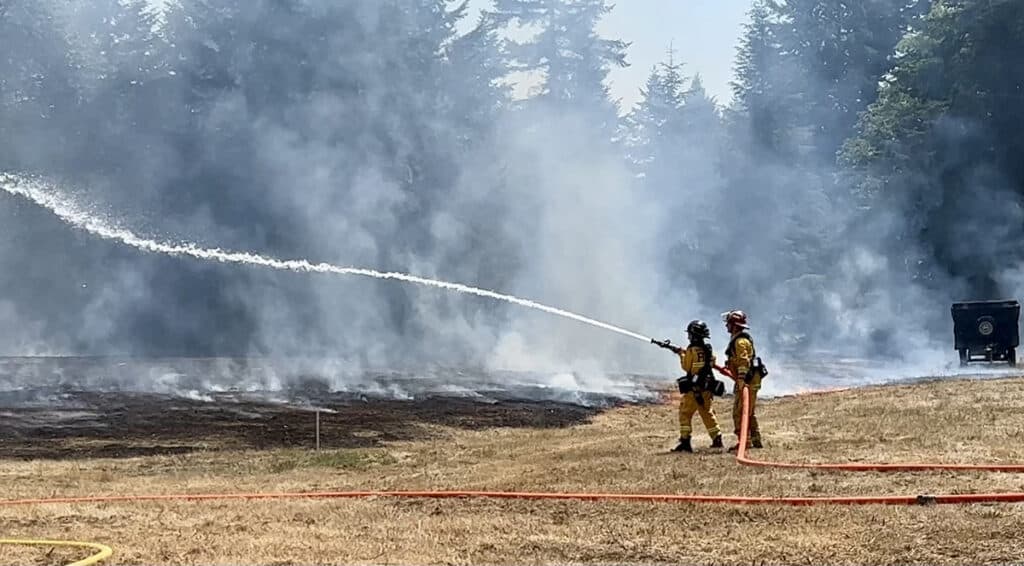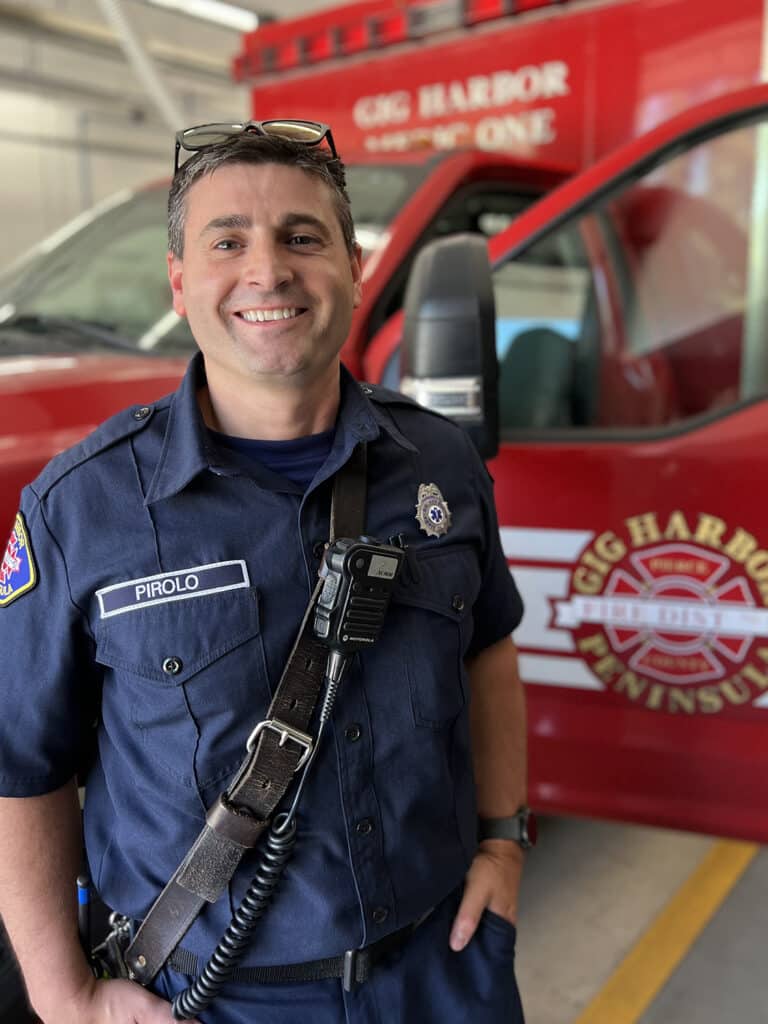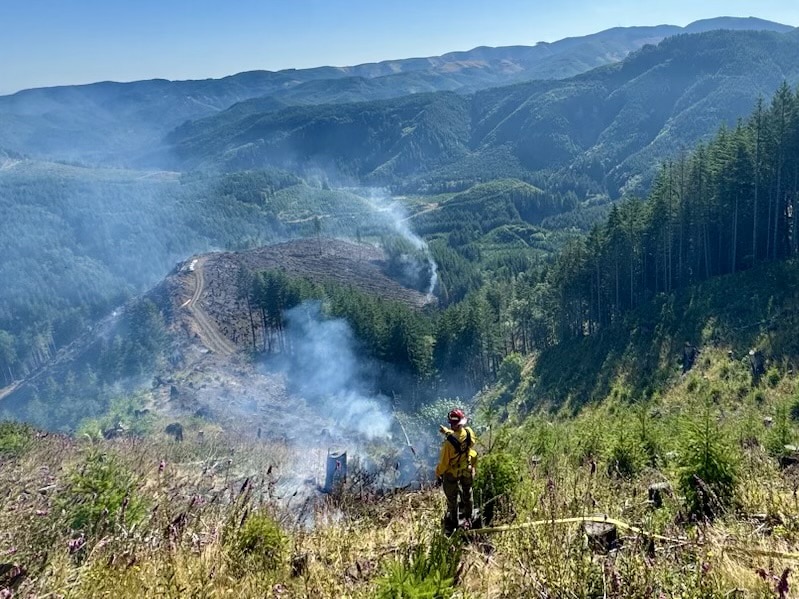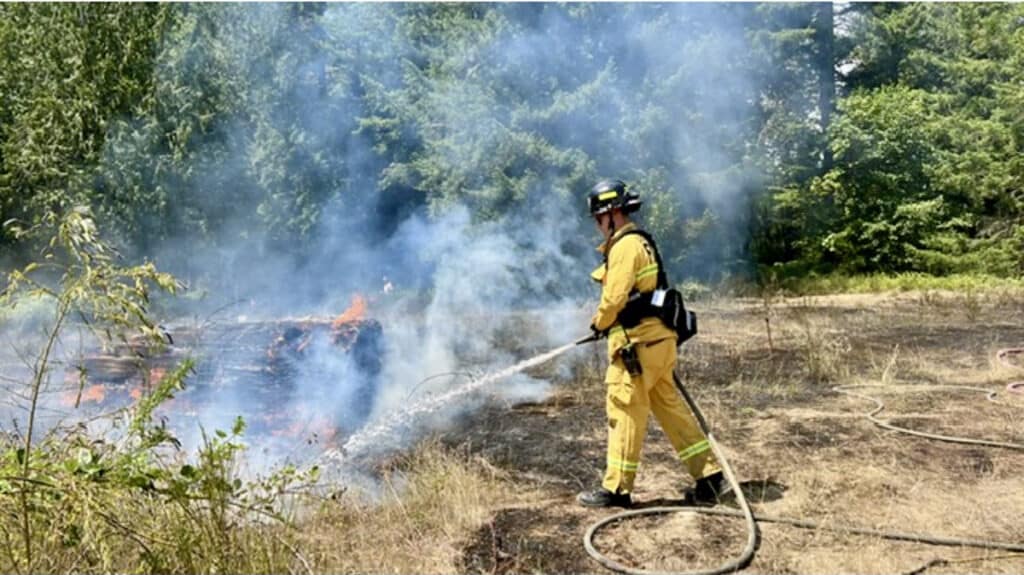Community Health & Wellness Police & Fire
Gig Harbor firefighters deploy to battle wildfires around the state
Two Gig Harbor Fire and Medic One firefighters have deployed to a 25,000-acre fire northwest of Chelan and three others are helping fight the Cougar Creek Fire in Southeast Washington, which has burned 13,511 acres as of July 25. Ten fires are currently burning across the state.
The department has maxed out its ability to deploy at this point, said Gig Harbor Fire and Medic One Lt. Josh Bissenas, the district’s wildland program lead.
“The chief and I sit down in May and look at how many are out on injury, are we low on staffing, and then we come up with a number,” Bissenas said. “We are maxed out right now at five, and the last two years we’ve sat around five or six.”
Firefighters return with valuable experience
Deployment to a wildland fire is crucial to helping communities across the state. But it also benefits Gig Harbor, Division Chief Scott Corigan said. Local firefighters gain experience while deployed that they bring home and use here.
The department responds to a few brush fires each week during the height of the fire season, said Tina Curran, public information officer for GHFMO.

Gig Harbor Fire and Medic One firefighters deploy around the state to help fight wildfires in other communities. When they come home, they have valuable experience and training in that work. Photo courtesy of Gig Harbor Fire and Medic One
Wildland firefighting is different from fighting a fire locally. Firefighters must meet the standards set by the National Wildfire Coordinating Group to be eligible for deployment. Corigan said firefighters can be deployed as a trainee as long as they are certified as a basic wildland firefighter.
“They will assist in operations under supervision of more experienced personnel, and can do hose laying, and mop-up operations,” Corigan said.
‘Deployed everything we have’
The Washington Department of Natural Resources leads wildland fire response in the state. But when the department needs extra hands, it asks for help from agencies throughout the state that have qualified personnel.
“The national preparedness level is 1-5 and we (the state) are at a 5,” Bissenas said. “That means that the wildland fire service has deployed everything that they have, and it isn’t August yet. We’re tipping toward being pretty busy for the end of July.”
Deploying local firefighters helps communities throughout the state, typically on the eastern side of the state. But Bissenas said communities on this side of the mountains increasingly see more fires. Experience and knowledge of fighting large fires is crucial to our community.

Gig Harbor Fire and Medic One firefighter/paramedic Dana Pirolo recently deployed to the Falls Fire near Burns, Oregon, where he served as a medical unit leader trainee. His responsibilities included planning and coordinating emergency response efforts, such as patient evacuations or extractions from remote areas. Photo courtesy of GHFMO
“Our intent is to have a robust program, and bring the experience and knowledge back to Gig Harbor so when we do have a fire, we have the knowledge to handle it and keep them small-scale,” Bissenas said. “The best way is to participate in the state mobilization program, and go out on large project fires. It’s becoming a more serious problem on the west side now. Gig Harbor needs to continue to do this work.”
GHFMO has participated since 2001, he said, and continues to be a leader in keeping trained personnel. Multiple Gig Harbor firefighters already have qualified as basic wildland firefighters, Bissenas said. About 17 more are training for various wildland firefighting roles.
Volunteers only
Wildland firefighting is part of the basic firefighter academy training for incoming recruits, Corigan said.
“When we get a new employee they have one week dedicated to just this topic,” he said. “So from academy on, this is a super relevant topic, and other agencies have implemented this in their academy, and have made it more normalized in our region. Our program provides tons of education and experience for those in deployments and it serves our community really well.”

Smoke swirls around charred ground at a wildland fire in the Lewis County community of Pe Ell. Photo courtesy of GHFMO
Firefighters deploy for up to two weeks, Bissenas said. But deployment is not required of every firefighter. They volunteer through a sign-up process. Bissenas works to make sure enough remain in each shift crew locally, so that a deployment doesn’t cause a staffing shortage for the department.
Once deployed, the firefighter is on the payroll of the state, and the local department is reimbursed once they return.
“What typically happens is GHFD pays upfront costs, and the firefighters come back with time cards and paperwork, and we submit for reimbursement to the state,” he said. “Another component to that is that the state also pays to backfill the position so there is no loss in staffing.”
Wildfire Ready
Locally, residents can help to prevent wildfires by participating in the Wildfire Ready Neighbors program, which provides a custom wildfire evaluation of their property, Curran said.
“One of the first things that we encourage citizens to do is make a plan, take a look at evacuation routes, and look at some of the things that you can control about your landscape,” Curran said. “We encourage a defensible space around their home, so that vegetation isn’t against the home, and that the gutters are cleaned, and that they are mindful of furniture on the decking. We call it hardening your home against wildfires. Often we have found the greatest success when neighbors are partnering to create a safe zone around the home.”
The department has conducted more than 50 of these free evaluations. Residents can sign up at wildfireready.dnr.wa.govor find information at gigharborfire.org or firewise.org.

Gig Harbor Fire & Medic One firefighters deploy around the state to help fight wildfires in other communities. When they come home, they have valuable experience and training in that work. Photo courtesy of Gig Harbor Fire and Medic One

